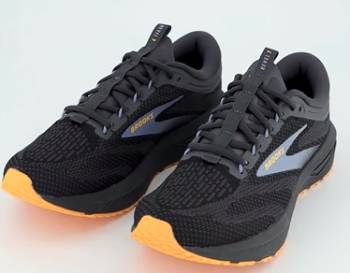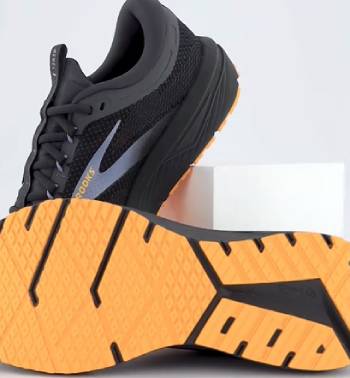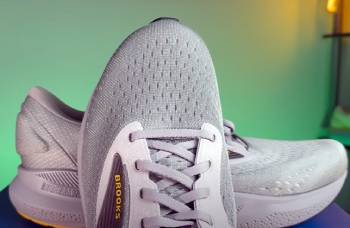I’m a runner who’s spent countless miles pounding pavement, trails, and treadmills, so I know the struggle of picking the perfect running shoe. In this article, I’ll break down the Brooks Revel and Brooks Adrenaline, two popular models from Brooks’ lineup, to help you decide which fits your running style.
I’ll cover their key features, weigh their pros and cons, and share insights from my own experience and research. Whether you’re a casual jogger or a marathoner, you’ll find clarity on which shoe suits your stride.
A Brief Comparison table
| Feature | Brooks Revel | Brooks Adrenaline |
| Type | Neutral | Stability |
| Weight | 8.9 oz (M), 8.0 oz (W) | 9.1 oz (M), 8.1 oz (W) |
| Heel-to-Toe Drop | 12 mm | 12 mm |
| Cushioning | BioMoGo DNA (Moderate) | BioMoGo DNA + DNA Loft (Moderate) |
| Arch Support | Medium to High | Medium to High (GuideRails) |
| Best For | Casual runners, daily training | Runners needing stability, long runs |
| Price Range | $100-$120 | $130-$150 |
| Durability | Good (300-400 miles) | Excellent (400-500 miles) |
| Fit | True to size, slightly snug | True to size, roomy toe box |
| Terrain | Road, treadmill | Road, light trails |
My Journey With Brooks Running Shoes
As someone who’s laced up for everything from 5Ks to half-marathons, I’ve learned that the right shoe can make or break your run. Brooks has been a go-to brand for me because of their focus on comfort and performance.
The Revel and Adrenaline caught my eye for different reasons: the Revel for its sleek, budget-friendly versatility, and the Adrenaline for its reputation as a stability workhorse. I’ve tested both, and I’m here to share what I’ve learned, blending my experience with insights to help you choose.
Understanding The Brooks Revel
The Brooks Revel is like that reliable friend who’s always up for a casual hangout. It’s a neutral running shoe designed for runners who don’t need extra stability features. I first tried the Revel during a period when I was logging easy miles around my neighborhood.
Its lightweight feel—8.9 ounces for men and 8.0 for women—made it a breeze to wear.
Key Features of The Revel

The Revel uses BioMoGo DNA cushioning, which adapts to your stride for a springy, responsive feel.
I noticed it’s not overly plush but provides enough bounce for daily runs.
The 12 mm heel-to-toe drop is standard for Brooks, promoting a natural stride.
The upper is a single-layer mesh, which I found breathable, especially on warm days.
The shoe’s flat-knit design gives it a modern, sock-like fit, though it can feel snug through the midfoot.
Pros of The Brooks Revel
- Affordable Price: At $100-$120, the Revel is a fantastic value for a high-quality running shoe. It’s perfect for runners on a budget who still want reliable performance without breaking the bank.
- Lightweight Design: Weighing just 8.9 ounces for men and 8.0 for women, the Revel feels nimble. I loved how it let me pick up the pace during speedwork without feeling weighed down.
- Versatile Style: The sleek, flat-knit upper makes the Revel a shoe you can wear beyond running. I’ve worn mine to the gym, casual outings, and even errands, and they blend seamlessly with athleisure or jeans.
- Breathable Upper: The single-layer mesh kept my feet cool during hot summer runs. Even during sweaty 6-mile runs, I didn’t deal with overheating or clammy feet.
- Responsive Cushioning: The BioMoGo DNA foam adapts to your stride, offering a balanced, springy feel. It’s not as plush as premium models, but it’s perfect for shorter runs or tempo sessions.
- Easy Break-In: I found the Revel comfortable right out of the box, with minimal break-in time. This is a big plus for runners who want to hit the ground running without waiting for the shoe to soften up.
Cons of The Brooks Revel
- Limited Durability: After about 300-350 miles, I noticed wear on the outsole, particularly under the heel. For high-mileage runners, this shorter lifespan might mean replacing them sooner than expected.
- Minimal Stability Features: As a neutral shoe, the Revel lacks support for overpronation. If you have flat feet or need motion control, you might feel unsupported, especially on longer runs.
- Snug Midfoot Fit: The sock-like design, while stylish, felt tight through the midfoot for me, especially after long runs when my feet swelled. Runners with wider feet might find it restrictive.
- Basic Cushioning: While responsive, the BioMoGo DNA foam isn’t as plush as higher-end options. I felt some fatigue on runs over 10 miles, making it less ideal for marathon training.
- Less Traction on Wet Surfaces: The outsole performs well on dry roads and treadmills, but I slipped slightly on wet pavement. It’s not built for slick conditions or technical trails.
- Not Ideal for Long Runs: The lighter cushioning and lack of stability make the Revel less suited for distances beyond 10 miles, where I started to feel the impact more.
Exploring The Brooks Adrenaline

The Brooks Adrenaline is the dependable, sturdy option for runners who need stability. I turned to the Adrenaline when I started noticing my knees aching after long runs, likely due to mild overpronation.
At 9.1 ounces for men and 8.1 for women, it’s slightly heavier than the Revel but feels solid and supportive.
Key Features of The Adrenaline
The Adrenaline features Brooks’ GuideRails technology, which gently corrects overpronation without feeling intrusive. Its cushioning combines BioMoGo DNA with DNA Loft for a softer, more forgiving ride.
The 12 mm drop matches the Revel, but the Adrenaline’s roomier toe box was a game-changer for me on longer runs. The engineered mesh upper balances breathability and structure, and the outsole grips well on roads and light trails.
Pros of The Brooks Adrenaline
- Superior Stability: The GuideRails system is a standout, subtly guiding your stride to prevent overpronation. I felt my knees and ankles were better protected during long runs, reducing fatigue and injury risk.
- Exceptional Durability: I logged over 450 miles in my Adrenalines, and the outsole and midsole held up impressively. This makes it a cost-effective choice for runners who rack up high mileage.
- Comfortable, Roomy Fit: The wider toe box was a blessing on runs over 10 miles, allowing my toes to splay naturally. It’s ideal for runners with wider feet or those who experience swelling during long sessions.
- Versatile Terrain Performance: The Adrenaline handles roads and light trails with ease. I tested it on gravel paths and found the outsole provided solid grip, even in slightly muddy conditions.
- Plush Cushioning: The combination of BioMoGo DNA and DNA Loft delivers a soft yet responsive ride. I appreciated the extra cushioning during half-marathon training, as it absorbed impact well.
- Support for Long Runs: The stability and cushioning make the Adrenaline a go-to for distances beyond 10 miles. I felt confident and comfortable during a 15-mile trail run, with no soreness afterward.
- Breathable Yet Structured Upper: The engineered mesh offers a great balance of ventilation and support. My feet stayed cool but secure, even during humid runs.
Cons of The Brooks Adrenaline
- Higher Price Point: At $130-$150, the Adrenaline is pricier than the Revel. For budget-conscious runners, the cost might feel steep, especially if you don’t need stability features.
- Slightly Heavier: At 9.1 ounces for men and 8.1 for women, it’s not as nimble as the Revel. I noticed the extra weight during speedwork, where it felt less agile.
- Less Stylish Design: The Adrenaline prioritizes function over fashion. Its bulkier look doesn’t transition as well to casual wear, which was a slight downside for me outside of running.
- Stiffer Break-In Period: It took about 20-30 miles to fully break in the Adrenaline. Initially, it felt rigid, which might frustrate runners who want instant comfort.
- Not Ideal for Speedwork: The added stability and weight make the Adrenaline less suited for fast-paced runs or sprints. I felt it lagged slightly during interval training.
- Overkill for Neutral Runners: If you don’t overpronate, the GuideRails might feel unnecessary. I noticed this when I lent them to a friend with a neutral stride who found them overly corrective.
Head-to-Head Comparison of Brooks Revel And Adrenaline
Let’s get into the meat of it: how do these shoes stack up against each other? I’ll compare them across key areas to help you see which aligns with your running needs.
- Cushioning and Comfort

The Revel’s BioMoGo DNA cushioning is responsive but lean, ideal for shorter, faster runs.
I felt it gave me enough bounce for 5-8 mile jaunts but started to feel firm on longer runs.
The Adrenaline, with its DNA Loft addition, feels softer and more forgiving, which I appreciated during 10+ mile sessions.
If you prioritize plush comfort, the Adrenaline wins, but the Revel’s lighter cushioning suits quick, casual runs.
- Stability and Support
This is where the Adrenaline shines. Its GuideRails system subtly corrects overpronation, which I found helpful when my form got sloppy late in runs. The Revel, being a neutral shoe, doesn’t offer this support.
If you have flat feet or overpronate, the Adrenaline is the better choice. For neutral runners, the Revel’s lack of stability features isn’t a drawback—it’s just not built for correction.
- Weight and Agility
The Revel is slightly lighter, which I noticed during speedwork. It feels more agile, letting me pick up the pace without feeling weighed down. The Adrenaline, while only a tad heavier, feels more planted, which is great for stability but less ideal for sprinting.
If you’re chasing speed, the Revel has the edge; for steady, long-distance runs, the Adrenaline feels more secure.
- Durability and Longevity
I put both shoes through their paces, and the Adrenaline outlasted the Revel. The Adrenaline’s outsole and midsole held up for around 450 miles, while the Revel showed wear closer to 350.
For runners logging high mileage, the Adrenaline’s durability is a big plus, though the Revel’s lifespan is respectable for its price.
- Fit and Sizing
Both shoes run true to size, but their fits differ. The Revel’s snug midfoot was noticeable for me, especially after long runs when my feet swelled. The Adrenaline’s roomier toe box felt more accommodating, particularly for wider feet.
If you prefer a snug, sock-like fit, the Revel works; if you need space, go with the Adrenaline.
- Price and Value
The Revel is the budget-friendly option, typically $20-$30 cheaper than the Adrenaline. For casual runners or those new to running, the Revel offers great value without skimping on quality.
The Adrenaline’s higher price reflects its advanced stability features and durability, making it worth the investment for serious runners or those with specific biomechanical needs.
- Aesthetic and Versatility
I’ll be honest: the Revel looks sleeker. Its flat-knit upper and streamlined design make it easy to wear casually. I’ve paired it with jeans for errands without looking like I just left the gym.
The Adrenaline, while functional, has a bulkier, more “running shoe” vibe. If style matters, the Revel might edge out; for pure performance, the Adrenaline doesn’t care about looks.
My Experience

To give you a real sense of these shoes, I tested them in various scenarios.
For the Revel, I ran 5-8 miles on roads and treadmills, mixing in some interval training. It felt light and responsive, but my feet felt fatigued after 10 miles.
The breathable upper kept my feet cool, but the snug fit became noticeable after an hour.
The Adrenaline was my go-to for long runs, including a 15-mile trail run.
The GuideRails kept my stride steady, and the cushioning absorbed impact well, even on uneven terrain. It took a few runs to break in, but once it did, it felt like an extension of my feet. The roomier fit was a relief during long sessions.
Who Should Choose Which Shoe?
Your choice depends on your running style, goals, and biomechanics. Let’s break it down.
- Brooks Revel: The All-Rounder
The Revel is perfect for casual runners, beginners, or those who want a versatile shoe. If you’re running 3-5 times a week, sticking to shorter distances (5-10 miles), and have a neutral stride, the Revel’s lightweight, affordable design is a great fit. It’s also a solid pick if you want a shoe that doubles as casual wear.
- Brooks Adrenaline: The Stability Star
The Adrenaline is ideal for runners who need stability, especially those with mild to moderate overpronation. If you’re training for longer races (half-marathons or marathons) or logging high weekly mileage, the Adrenaline’s durability and supportive features shine.
It’s also great for runners with flat feet or those who want a shoe that can handle varied terrain.
Frequently Asked Questions (FAQ)
Casual runners, beginners, or those with neutral strides who want a lightweight, affordable shoe for short to medium runs.
Runners needing stability, especially those with mild to moderate overpronation, or training for long distances like half-marathons.
Flat feet or those with mild to moderate overpronation, thanks to the GuideRails system.
The Revel is a neutral shoe, designed for runners without significant overpronation.
Wrapping Up
You’re out there chasing your running goals, and I hope this breakdown of the Brooks Revel and Adrenaline helps you pick the shoe that feels like home.
The Revel’s lightweight, budget-friendly vibe is great for casual runners, while the Adrenaline’s stability and durability make it a go-to for serious mileage. Consider your stride, distance, and terrain, and you’ll find the right fit.
Happy running, and may your next pair carry you to new personal bests!

